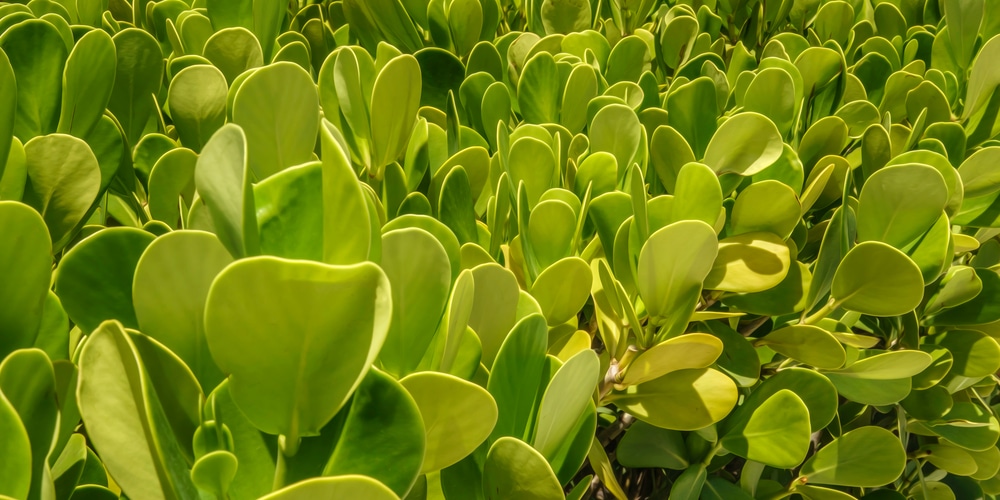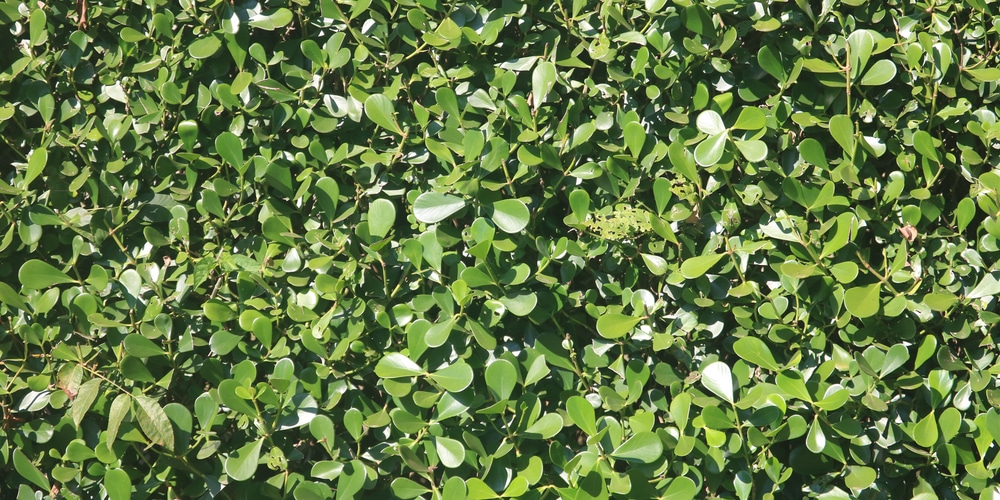A medium-sized, fast-growing evergreen shrub, the Clusia hedge serves as an excellent screen with its significant, oval-shaped leaves and sprawling habit.

| Botanical Name | Clusia guttifera |
| Common Name | Small Leaf Clusia, Clusia Hedge |
| Plant Type | Perennial Evergreen |
| Flower Color | Pink-white blooms |
| Size When Mature | 300 inches |
| Bloom Time | Summer |
| Sun Requirements | Full Sun to Partial Shade |
| USDA Hardiness Zones | 10 and 11 |
| Soil PH Range | 5.5 to 6.5 |
| Soil Type | Well-draining, sandy |
| Water Needs | Low |
| Native Area | US and Mexico |
What you Need to Know About The Clusia Hedge
The Clusia Hedge, or Clusia guttifera, serves as an interesting landscape specimen with its large, rippled oval leaves and semi-formal appearance. True to its common name, the Clusia Hedge works best as a screen or privacy hedge because of its large semi-succulent foliage, quick growing habit, and high tolerance to salt, drought, and searing summers.
The Small leaf clusia is harmless most of the time, but dogs and small children should not consume the fruit that forms after the plant flowers. However, if you can look past this then you’ll find the evergreen shrub or small tree a reliable landscape fixture that practically lives forever. Once mature and established, the clusia hedge form buds that turn into pink-white blooms in the summer season.
How to Care for the Clusia Hedge
Here’s everything you need to know about growing and caring for a thriving Small Leaf Clusia
Light
If you’re looking for a privacy screen that can survive days of direct sunlight and salt, then the Clusia Hedge should be at the top of your list. You can train the Clusia to grow as a shrub or tree depending on what you need, but part of the deal is that the Clusia has to be planted in a sunny spot.
The Clusia Hedge can still work where there’s partial shade, although it won’t be as robust or produce as many small, pink-white flowers come summertime. The evergreen shrub is versatile enough that it can act as a standalone highlight specimen or in rows if you want to set up a natural screen.
Water and Soil Needs
Did you know that the clusia hedge is a semi-succulent shrub? This means that you won’t need to water them as much since these plants tend to store water in their stems and leaves. A once-weekly thorough watering should be enough to keep Clusia happy and thriving even in a punishing environment.
If you’re wondering how to plant a Clusia hedge, you should first consider the type of soil in your yard. Clusia prefers a loose, well-draining soil that has organic matter such as aged compost mixed in. You can add gravel or sand to improve the composition and draining capacity. As for soil pH, the Clusia doesn’t have a special preference and can take to either acidic or alkaline soil well.
Temperature Requirements
The Clusia Hedge can thrive in USDA zones 10 and 11. The hotter the environment and the more sun it gets, the healthier your evergreen shrub will be. It’s recommended that you grow the plant in temperature ranges of 50 degrees F and above, with the lowest being 30 degrees F (or minus 1 degree C).
Fertilizer
The best fertilizer to use on a Clusia Hedge is a balanced fertilizer during its growing season.
A balanced formula in the NPK, or nitrogen, phosphorus, and potassium department should serve to feed your small leaf clusia well. You can get a 10-10-10 mix in either granulated, slow-release, or liquid form and follow the instructions on the label to avoid fertilizer burn.
It’s recommended that you feed your clusia hedge at the start of every season, in spring, summer, and fall to support the shrub’s rapid growth. Don’t forget to time it so you can water the fertilizer immediately afterward.
Common Diseases
The Clusia Hedge can suffer from fungal diseases and leaf yellowing caused by overwatering. In the same vein, the shrub can get affected by insects such as thrips and scale.
Since the clusia is a semi-succulent variety it tends to do very well even if you forget to water it now and then. The shrub will simply collect moisture from the soil or air and stay alive that way. However, clusia hedges may not be able to tolerate overwatering, or sitting in soggy soil for too long. You’ll know that a clusia is unhappy when there’s yellowing of leaves and black spots in the foliage.
Thrips and scales may be avoided the same way. Water only the ground and not the leaves and stems, and your Clusia Hedge should live a long time. Alternatively, you can spray with soap and water or a solution of neem oil.
Clusia Hedge Propagation
Clusia plants can easily be grown from cuttings. All you need is a pair of sharp pruning shears, a healthy specimen, and a pot that has well-draining media.
Look for healthy specimens in late spring or early summer, then use pruning shears to cut off four or six-inch stems. Remove the lower leaves to expose the nodes, then place the cutting into a pot with well-draining and loose soil. Water the soil and keep it constantly moist to encourage roots to form.
After four to six weeks the cuttings will have formed roots. At this time, you can transplant outside or to a larger container. Treat as a new Clusia Hedge with the same growing requirements as the mature shrub.

